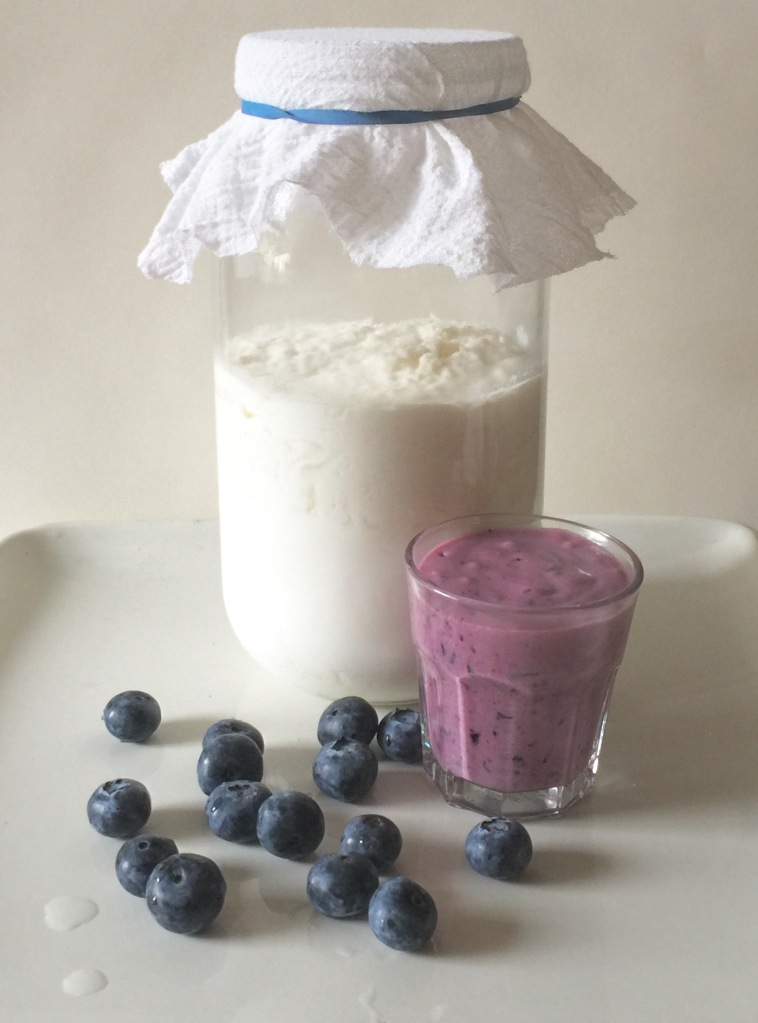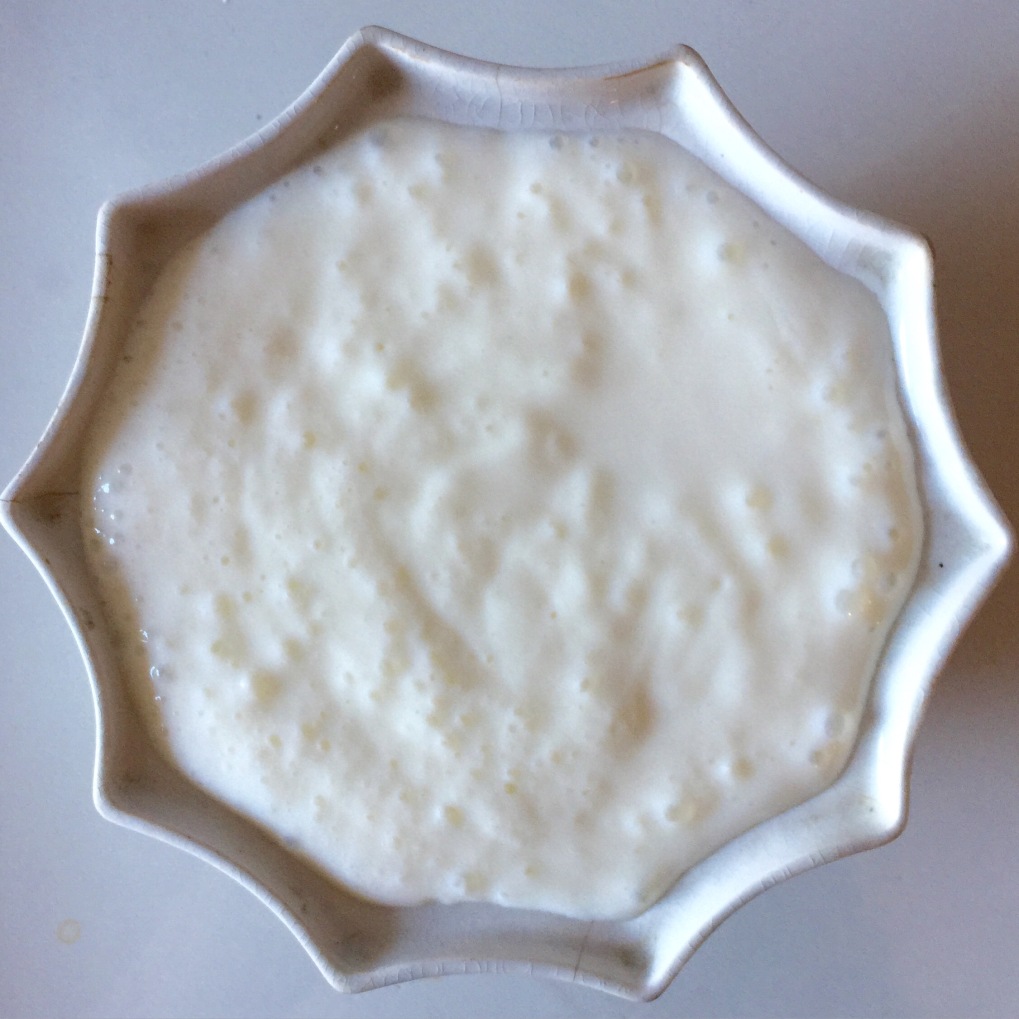
Spring is in the air, the English countryside in East Devon is humming with bird song, the trees are suddenly bright with with electric green leaves unfurling from their sleepy brown branches. Blossom from the apple tree is fluttering down like flowery snow covering the ground like a carpet of petals, making everything feel brand new and fresh. There is nothing which connects me more to the here and now and with such gratitude than when England throws off her winter cloak and blesses us with a sunny day.

Along with the arrival of spring came two new baby goats. Within moments of being born they were standing on shaky bambi legs, nudging at their mothers udders and rooting for the milk to come in. For me, the birth of the kids signals fresh raw goats milk to feed my Kefir grains, knowing that they too will be grateful for the rich spoils of Spring.

Nine years ago my health was transformed when I took my first small lump of kefir home and began to nurture it so that it grew big enough to make kefir yoghurt. I had only vaguely heard of Kefir from my cousin in LA who swore by it. When she came to stay with me she would travel with bottles of it in her suitcase and put it in my fridge. A few years later when I was visiting a good friend I caught sight of jar of Kefir sitting on her worktop, I was filled with curiosity. What first caught my attention was that it was something to take care of. My maternal instinct took over with the thought of baby kefir grains needing an adoptive mother. It wasn’t until I was driving home that I looked at the jar of baby grains nestled in my basket that I realised they would need feeding.

What Kefir grains thrive on is fresh milk. It dawned on me with a rather frightening jolt that I would have to buy Cows milk or maybe less frightening Goats milk! Its not that either of these two options are bad, its just that up until this point due to various health issues I had been dairy free for years. Putting my worries aside I fed my new Kefir grains with the freshest milk I could find. They in turn rewarded me twofold, first by providing me with a delicious probiotic yoghurt style drink and second healing me from recurring yeast infections, adult acne and the psoriasis I had suffered from since childhood. Since then Kefir has become a much loved and cherished part of my life, I have never looked back and my skin and general health has never been better.
I began to research kefir and one thing that became clear to me was that it is a very special food. Dairy is often not recommended because it contains a milk sugar called lactase that feeds yeast and creates mucus. However Kefir doesn’t feed yeast, which means that many people who are lactose intolerant can eat it with no ill effects. This is because it contains friendly bacteria and yeasts which consume almost all the lactose in the milk, and also provides a very efficient enzyme called lactase which consumes whatever lactose is left over during the fermentation process. Even though Kefir is slightly mucus forming this mucus actually benefits us by helping to line and protect our digestive tract. This creates a perfect environment in which beneficial bacteria can settle and re-colonise. It also gives a good foundation for any probiotics you might be taking, allowing them to really take hold and thrive, resulting in a kind of ‘gut garden’ (also known as the microbiome).

It’s quite misleading when you hear the word Kefir grains. They are not actually grains in the normal sense but are gelatinous white or creamy lumps which resemble cottage cheese or small cauliflower heads. These particles are symbiotic cultures of bacteria and yeast (SCOBY) held together by a polysaccharide produced by the beneficial bacteria Lactobacillus Higarii.
Kefir grains are a natural phenomena, they cannot be manufactured by artificial means but are an ancient organism going back thousands of years. They were said to have come originally from the mountains of the Caucasus and were a closely guarded secret. Grains were historically handed down through the generations like a precious heirloom. They are an eternal food source and if you take care of them they will last you a life time and beyond.
How to Make Kefir
The procedure of making Kefir is actually very simple. Once you have procured your grains place them in a very clean large glass jar. Pour over your milk, either cow or goats milk, leaving plenty of space at the top. Cover with a paper towel or some fabric and secure with a rubber band. Place out of direct sunlight somewhere warm, ideally between about 68F and 78F. A simple ratio for Kefir grains to milk is about 1 tbs of grains to 2 cups of milk. Leave to ferment for about 24 hours. When it is ready you will see that the milk has thickened up quite a bit and that the curds and whey are separating. Strain through a plastic sieve or colander, you can help ease the kefir through the sieve by agitating the sieve and/or carefully stirring with a wooden spoon. Be mindful to use a light touch so that you don’t damage the Kefir grains. Put the Kefir grains back into a clean jar and pour fresh milk over the top thus starting off the whole process again. I know some people like to rinse their grains but I have never found this necessary and in fact think it actually harms them. Another thing which will harm your grains is for them to touch metal, so always use a plastic sieve and a wooden or plastic spoon when straining. Use the freshest milk you can find, preferably organic non-homogeonised semi-skimmed or whole milk. Raw milk is the gold standard but not easily come by.
What you are left with is a drinkable yoghurt style product which ranges from mild to refreshingly tart. It can have an effervescent quality which is a good thing and shows that your Kefir grains are very happy and that it is probiotic rich! It is not called the ‘Champagne of Milk’ for nothing.
Here is a short video which illustrates the steps:
https://www.youtube.com/watch?v=5FeQBqLAeTQ
Kefir makes delicious smoothies to which you can add whatever soft fruit you have on hand.
Blueberry Kefir Smoothie

1 Cup of Kefir
1 Cup of Blueberries
1/2 Banana
3-4 Dates
Combine all the ingredients either in a blender or you can use an immersion blender for simplicity. Blend together until smooth.
A great resource for all things kefir is Dom’s kefir making site.
http://users.chariot.net.au/~dna/kefirpage.html
To get your own grains contact me at themirabelletree@gmail.com and if I have spare I will let you have them for the price of P&P as long as you pass any surplus you have on to anyone else who would like them. If I don’t have any spare you can usually buy them from ebay or gumtree.

4 thoughts on “Making Kefir and a Blueberry Smoothie”